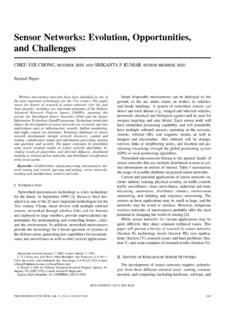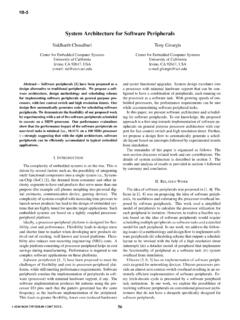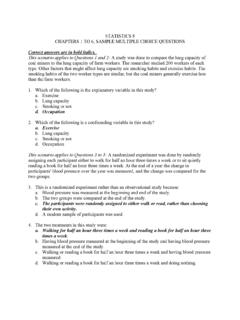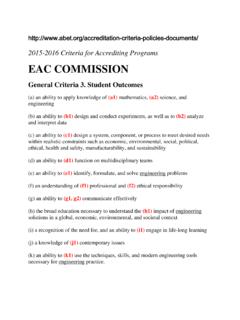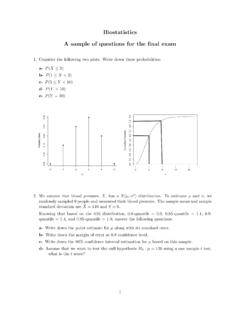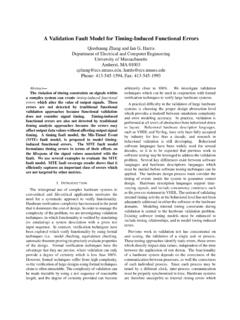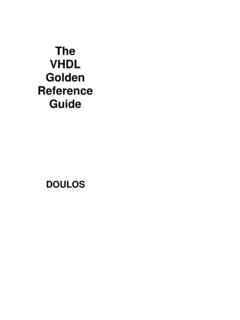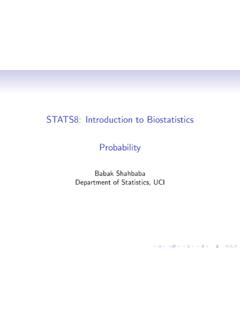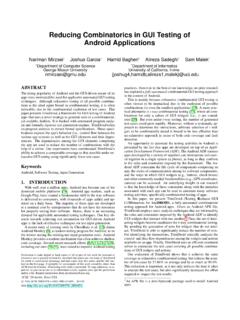Transcription of Computer Networks - CS132/EECS148 - Spring 2013
1 Computer Networks - CS132/EECS148 - Spring 2013 Instructor: Karim El Defrawy Assignment 1 Deadline : April 18th 9:30pm (hard and soft copies required) Each problem has 10 points. ---------------------------------------- ---------------------------------- Problem 1 - Consider a packet switching architecture. a. What are the main components of delay when we use packet switching? Processing delay, queuing delay, transmission delay and propagation delay b. What is the difference between transmission delay and propagation delay? Transmission delay is the time needed to put the entire packet on the link and is dependent on the length of the packet, while the propagation delay is needed time for one bit to reach to the other end of the link. c. How is propagation delay affected if the length of the packet is increased? This delay is just a function of link length and its physical characteristics, so it is NOT affected.
2 Problem 2 - Consider an application that transmits data at a steady rate (for example the sender generates an N-bit unit of data every K time units, where K is small and fixed). Also, when such an application starts, it will continue running for a relatively long period of time. Answer the following questions, briefly justifying your answers. a. Would a packet-switched network or a circuit-switched network be more appropriate for this application? Why? A circuit-switched network would be well suited to the application, because the application involves long sessions with predictable smooth bandwidth requirements. Since the transmission rate is known and not bursty, bandwidth can be reserved for each application session without significant waste. In addition, the overhead costs of setting up and tearing down connections are amortized over the lengthy duration of a typical application session.
3 B. Suppose a packet-switched network is used and the only traffic in this network comes from this application as described above. Furthermore, assume that the sum of the application data rates is less than the capacities of each and every link. Is some form of congestion control needed? Why? In the worst case, all the applications simultaneously transmit over one or more network links. However, since each link has sufficient bandwidth to handle the sum of all of the applications' data rates, no congestion (very little queuing) will occur. Given such generous link capacities, the network does not need congestion control mechanisms. Problem 3 (Similar to Problem 9 in Ch1 in Kurose/Ross) - Consider the difference between circuit switching and packet switching. Assume the link s rate is 2 Mbps and users are generating data at a rate of 100 Kbps when busy.
4 Users are busy only %1 of time. Problem 9 of chapter 1. Numbers are changed. a. What is the maximum number of users that a circuit switching architecture can support simultaneously? 2 Mbps / 100 Kbps = 20 users b. Write down the formula to calculate the probability of having more than 5 active users, assuming that we have 20 users in total. (Taught in discussion class) 1 - (C(20,0) ^20 + C(20,1) * ^19 + .. + C(20,5) ^5* ^15) c. Explain the effects of having more users in a packet switching architecture with the above characteristics. The probability of having more than 20 users simultaneously increases, so the buffers in routers become fuller and gradually packets will be dropped. Problem 4 (Similar to Problem 25 in Ch1 in Kurose/Ross) -Suppose two hosts, A and B, are separated by 10,000 kilometers and are connected by a direct link of R = 2 Mbps.
5 Suppose the propagation speed over the link is * 10^8 meters/sec. Problem 25 - Chapter 1 (numbers are changed) a. Calculate the bandwidth-delay product , R * d_prop. 2 Mpbs * (10000*1000 / ( *10^8)) = Mb b. Consider sending a file of 1000,000 bits from host A to host B. Suppose the file is sent continuously as one large message. What is the maximum number of bits that will be in the link at any given time? Maximum number of bits : M bits c. Provide an interpretation of the bandwidth-delay product. It is the maximum number of bits that the link can contain in the same time. Problem 5 - Suppose a user wants to load a simple static HTML page into his/her browser. Also assume RTT is 5 seconds and the total needed time for the page to be transferred is 4 seconds. Draw a diagram showing different steps of this process and calculate the time it takes from the initial request to the server until the user receives the file completely.
6 Draw the diagram (or similar one) provided in page 102 in the book. The total time is: 2*RTT + total file transfer time = 2*5 + 4 = 14 seconds. Problem 6 - Consider visiting Google s main search page. Write down the HTTP request/response format and fill out different parts of the packet (method, URL, version , status code .. ) according to this case. Note: You can use Firebug plugin for Firefox or Inspect Element feature of Chrome to see what you have in your sending/receiving packets. Write down the HTTP request/response format provided in pages 105 and 107 and fill them out with information from request to get (method is GET, version depends on browser, URL is , no headers , status should be 200 OK .. ) [Optional, Extra Credit] Problem 7 - Perform a traceroute between source and destination on the same continent at three different hours of the day.
7 A. Find the average and standard deviation of the round-trip delays at each of the three hours. b. Find the number of routers in the path at each of the three hours. Did the path change during any of the hours? c. Try to identify the number of ISP Networks that the traceroute packets pass through from source to destination. Routers with similar names and/or similar IP addresses should be considered as part of the same ISP. In your experiment do the largest delays occur at the peering interfaces between adjacent ISPs? d. Repeat the above for a source and destination on different continents. Compare the intra-continent and inter-continent results. On linux you can use the command traceroute and in the Windows command prompt you can use tracert In either case, you will get three delay measurements. For those three measurements you can calculate the mean and standard deviation.
8 Repeat the experiment at different times of the day and comment on any changes. Here is an example solution: Traceroutes between San Diego Super Computer Center and a) The average (mean) of the round-trip delays at each of the three hours is ms, ms and ms, respectively. The standard deviations are ms, ms, ms, respectively. b) In this example, the traceroutes have 12 routers in the path at each of the three hours. No, the paths didn t change during any of the hours. c) Traceroute packets passed through four ISP Networks from source to destination. Yes, in this experiment the largest delays occurred at peering interfaces between adjacent ISPs. Traceroutes from (France) to (USA). d) The average round-trip delays at each of the three hours are ms, ms and ms, respectively.
9 The standard deviations are ms, ms, ms, respectively. In this example, there are 11 routers in the path at each of the three hours. No, the paths didn t change during any of the hours. Traceroute packets passed three ISP Networks from source to destination. Yes, in this experiment the largest delays occurred at peering interfaces between adjacent ISPs.
